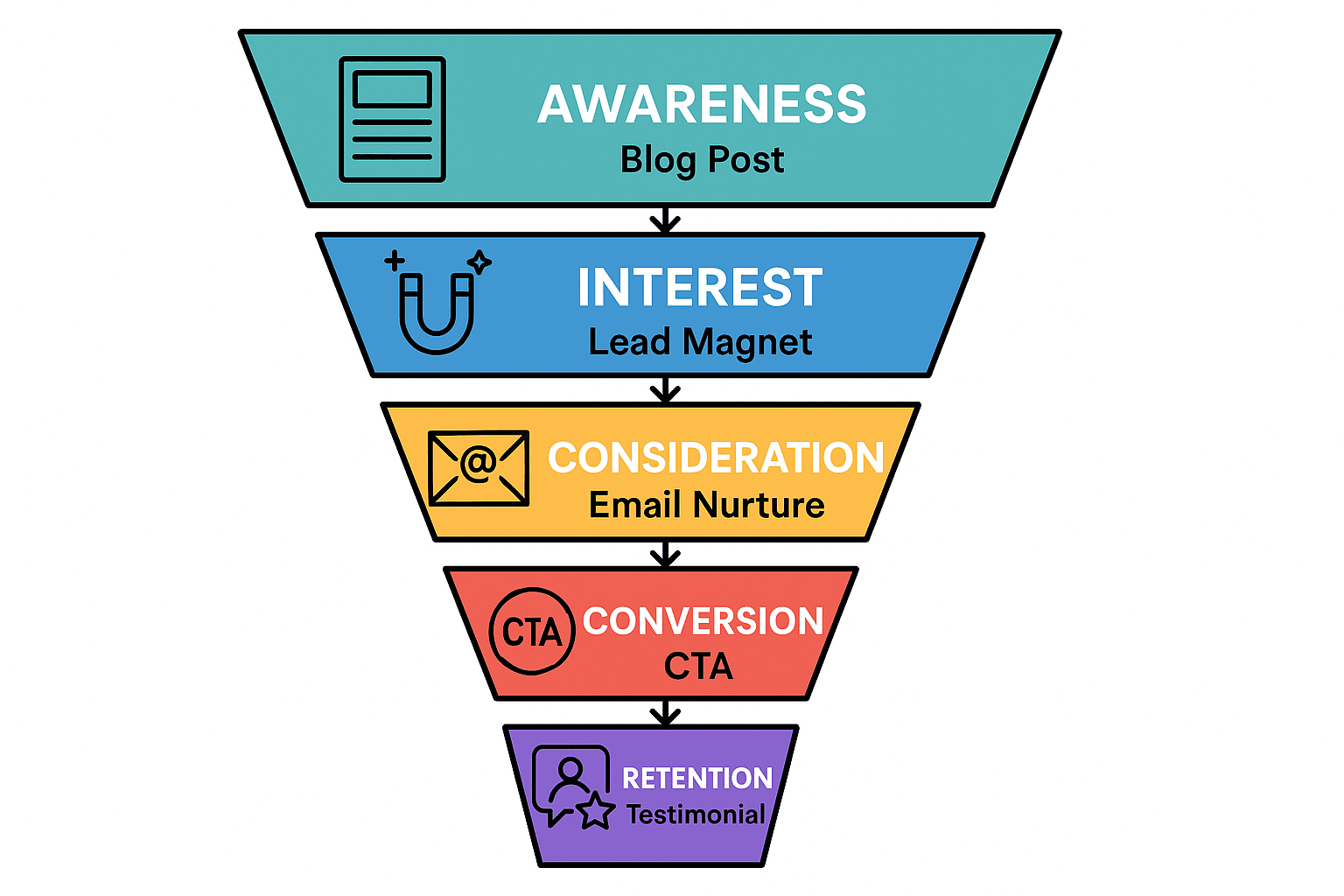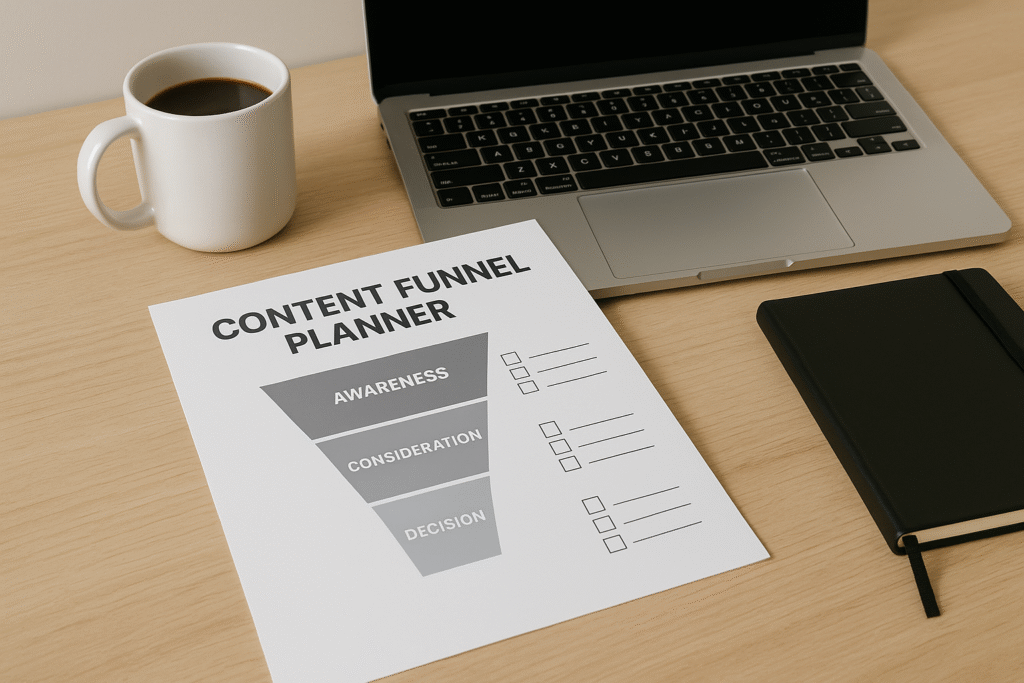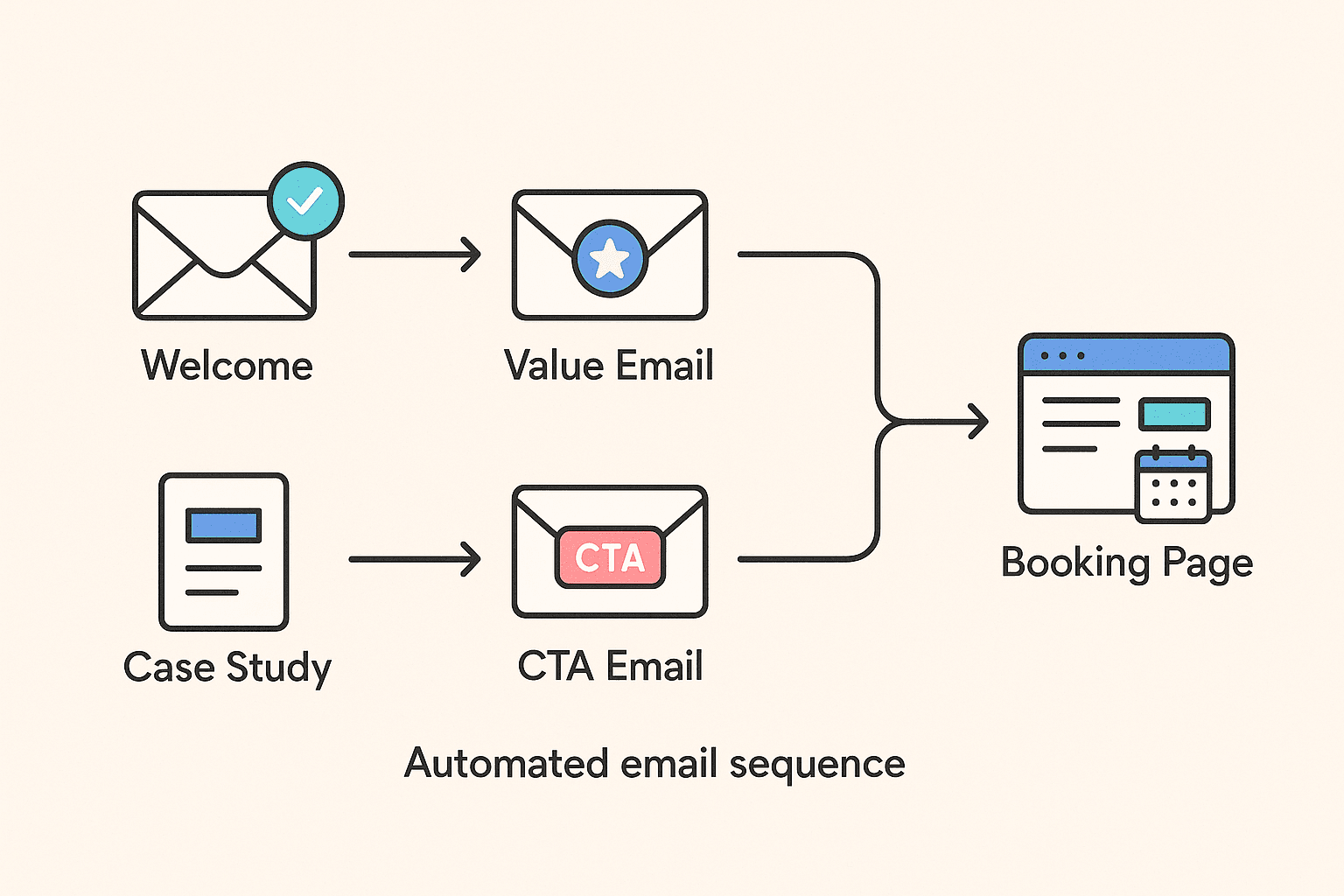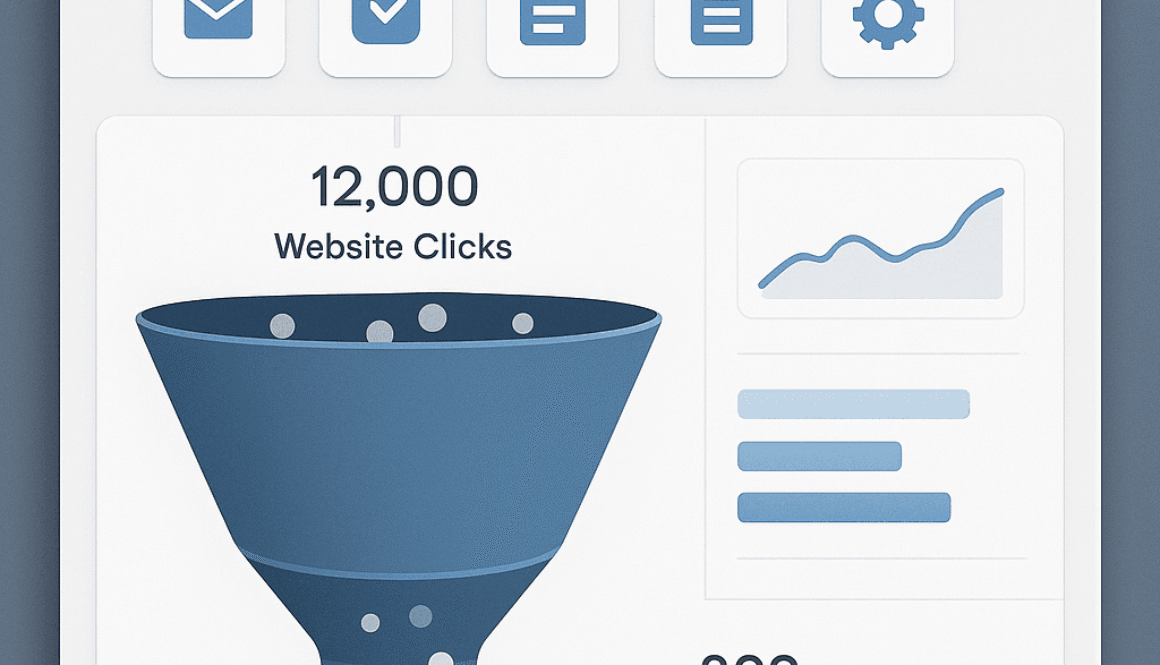From Clicks to Clients: How to Build a High-Converting Content Funnel in 2025
Let’s be real for a second.
Everyone’s chasing traffic these days. LinkedIn is full of humblebrags like:
“We hit 100K blog visitors this month!”
Cool. But ask them how many of those visitors turned into actual customers and… crickets.
Last month, I worked with a SaaS startup getting 75,000 monthly visits. Sounds like they were crushing it, right?
Their customer acquisition from all that traffic?
Twelve people.
Yep, just 12. That’s a 0.016% conversion rate.
Unfortunately, this isn’t rare. Most businesses are stuck playing the content lottery. Publish, hope Google notices, maybe go viral, fingers crossed for results.
Meanwhile, their competitors — with half the traffic — are quietly closing deals, nurturing leads, and building pipelines.
What’s the difference?
They’ve figured out something most folks overlook:
Traffic doesn’t pay the bills. Conversion does.
In this post, I’m going to show you exactly how to build a content funnel that actually converts. Not theory. Not fluff. Just the real system I use with clients to turn high traffic into high-value leads.
Why Most Content Funnels Are Broken (And You Might Not Even Know It)

Let me take a guess at your current content strategy:
- You research keywords
- You write some SEO-friendly blog posts
- You hit publish
- You check analytics
- You wait
- Still no leads.
Sound familiar? You’re not alone. That’s how 90% of businesses start.
But here’s the issue — you’re speaking to everyone without knowing where they are in their journey. And that’s a problem.
Think about your own buying behavior.
Say you’re looking for a project management tool. Did you go from “Hmm, we need to work better” straight to “Let’s buy [insert tool] now”?
Of course not.
You probably followed a path like this:
- First: You felt something wasn’t working
- Then: You started Googling what’s out there
- Finally: You compared a few tools and made a choice
Your audience is doing the exact same thing. But most content assumes readers are already in buying mode. They’re not — and that’s why conversions stay low.
The 3-Stage Funnel That Actually Works
Here’s the framework I use to fix that broken content system:
Stage 1: Problem Recognition
Your audience feels something’s off, but they can’t name the exact issue yet.
Stage 2: Solution Exploration
Now they’ve figured out the problem and are actively researching solutions.
Stage 3: Provider Selection
They’re ready to buy and choosing between providers.
Each stage needs its own content, messaging, and calls-to-action. Let’s break it down.
Stage 1: Problem Recognition (Top of Funnel)

What your audience is thinking:
“Something’s wrong, but I’m not sure what to do about it.”
This is where most people start their journey. They’re googling frustrations, not solutions.
Examples:
- “Why is no one opening my emails?”
- “Team keeps missing deadlines”
- “Why is my website traffic not converting?”
Notice anything? These aren’t product searches — they’re pain points.
Content That Works Here:
- “5 Signs Your Workflow Is Costing You Clients”
- “Why Your Marketing Emails Are Going Straight to Spam”
- “How to Spot Bottlenecks in Your Client Onboarding Process”
This is not the time to pitch your product. It’s the time to show empathy, educate, and build trust.
Keyword Tip:
Focus on informational keywords tied to real problems. Think:
- “why is…”
- “how to fix…”
- “signs your…”
Conversion Strategy:
Offer simple diagnostic tools or helpful checklists. Examples:
- “Marketing Health Checklist”
- “Team Productivity Scorecard”
- “Workflow Bottleneck Detector”
Your goal: Help them understand their problem better — not sell just yet.
Stage 2: Solution Exploration (Middle of Funnel)
What they’re thinking now:
“Okay, I know the problem. Now what are my options?”
This is where many businesses mess up — they go straight into selling. But your audience isn’t ready for that yet. They’re researching, comparing, and trying to make sense of the landscape.
Content That Converts:
- “Email Marketing vs. Marketing Automation: What’s Right for You?”
- “7 Ways to Boost Team Productivity (Without Adding More Meetings)”
- “Complete Guide to Building a Content Funnel That Converts”
- “How We Helped [Client Name] Increase Conversions by 3X”
This is the education stage. Your job is to become their trusted guide — not the annoying sales rep.
Keyword Tip:
Target commercial investigation keywords like:
- “Best [tool type] for [problem]”
- “[Option A] vs [Option B]”
- “Top [tools] for [use case]”
- “How to choose a [solution]”
Conversion Strategy:
This is the perfect time to offer lead magnets.
Give them:
- Side-by-side comparison charts
- ROI calculators
- “Solution Selector” guides
- Templates for evaluating vendors
Collect their email, deliver value, and nurture the relationship.
Stage 3: Provider Selection (Bottom of Funnel)
What they’re thinking now:
“I’m ready to buy. Who should I go with?”
This is the decision stage. They’ve done the homework, and now it’s go-time.
Content That Converts:
- Detailed case studies
- “[Your Company] vs [Competitor]” breakdowns
- ROI calculators
- “Behind the Scenes” of how you work
- FAQ or objection-handling articles
- Cost breakdowns or pricing guides
Be direct, transparent, and helpful.
Keyword Tip:
Focus on branded, high-commercial intent keywords:
- “[Your company] reviews”
- “[Your product] pricing”
- “Buy [product]”
- “[Your brand] vs [competitor]”
Conversion Strategy:
Make it easy to say yes:
- Offer demos
- Free consultations
- Implementation previews
- Clear guarantees
- Remove all friction
How I Do Keyword Mapping (So You’re Not Just Guessing)
Here’s the exact keyword classification system I use:
Stage 1: Problem-Aware
- “Why is my X not working?”
- “How to fix Y”
- “Signs of bad Z strategy”
Stage 2: Solution-Aware
- “Top X tools for Y”
- “X vs Y comparison”
- “How to choose the right Z”
Stage 3: Purchase-Ready
- “[Brand] reviews”
- “[Brand] pricing”
- “Schedule demo with [Brand]”
Pro tip: Don’t chase search volume. Chase intent. A keyword with 300 monthly searches but high conversion beats 10,000 low-intent looky-loos.
The Tech Stack Behind a Funnel That Converts
Email Capture Tips by Funnel Stage:

Stage 1 Offers:
- “Free Workflow Checklist”
- “Common Mistakes to Avoid”
- “Trend Report: What’s Changing in Your Industry”
Stage 2 Offers:
- “Compare Tools Cheat Sheet”
- “ROI Calculator”
- “How to Choose a [Tool] Guide”
Stage 3 Offers:
- “Book a Free Audit”
- “Download Our Pricing Sheet”
- “Watch a Demo Walkthrough”
Retargeting that Follows the Funnel
Stage 1 Visitors → Show them Stage 2 content
Stage 2 Visitors → Serve Stage 3 offers
Stage 3 Visitors → Use urgency or social proof (limited-time demo, testimonials, etc.)
Email Sequences that Build Trust, Not Annoyance
Stage 1 Sequence (5 emails)
- Resource delivery
- Common pain points
- Industry insight
- Case study or story
- Invite to explore options
Stage 2 Sequence (4 emails)
- Comparison guide
- In-depth breakdown of options
- Social proof
- CTA to book a call or get a free tool
Stage 3 Sequence (3 emails)
- Reminder of value
- Objection handling
- Direct CTA with bonus/incentive
Quick Wins That Boost Conversions Fast
Content Upgrades (Not Generic Popups)
Instead of: “Subscribe to our newsletter”
Use: “Download the [specific checklist] mentioned in this article”
Internal Linking with Purpose
- Stage 1 → Stage 2 content
- Stage 2 → Stage 3 content
- Every blog post = a guided journey
Exit-Intent Offers
- Awareness reader? → Offer educational PDF
- Comparison reader? → Offer tool comparison
- Decision-stage visitor? → “Want a free walkthrough?”
Common Mistakes That Kill Content Funnels
- Using the same CTA for everything
- Publishing awareness content but linking to pricing pages
- Skipping middle-of-funnel content entirely
- Ending posts without a “next step”
- Measuring only traffic, not progression
Metrics That Actually Matter
Stage 1:
- Email opt-in rate
- Time on page
- Shares/comments
Stage 2:
- Lead magnet downloads
- Email click-through rates
- Tool usage or guide engagement
Stage 3:
- Demo bookings
- Free trials
- Revenue from specific content pieces
Your 90-Day Funnel Game Plan
Month 1: Audit + Awareness
- Map all content to funnel stages
- Fill gaps (likely missing Stage 2)
- Create 3–4 new problem-focused blog posts
- Add content-specific lead magnets
Month 2: Educate + Nurture
- Create 4–5 solution-exploration pieces
- Launch lead magnets + retargeting
- Build Stage 2 email flows
Month 3: Close + Optimize
- Create 2–3 decision-stage pieces
- Launch nurture emails for leads
- Improve internal linking
- A/B test CTAs and upgrade offers
Final Thoughts: Stop Selling, Start Guiding
Most businesses are still playing the content lottery — hoping a viral post saves the quarter. The winners? They’re building systems. They’re showing up with real value at every stage, not just shouting “Buy now!” from their blog header. Help first. Sell later. That’s how you win in 2025. Build trust. Educate with empathy. And watch your blog stop being a brochure — and start becoming your best salesperson.
